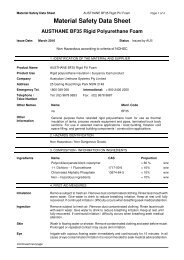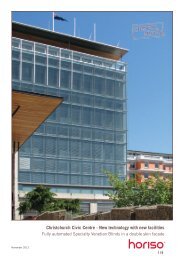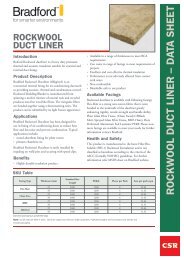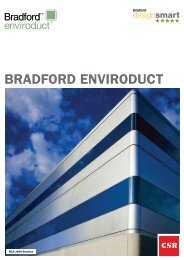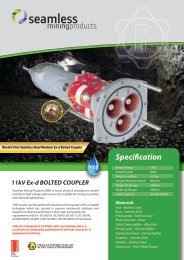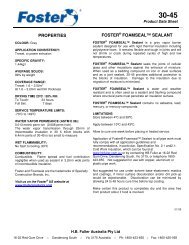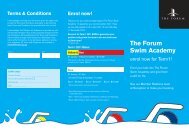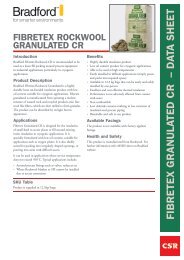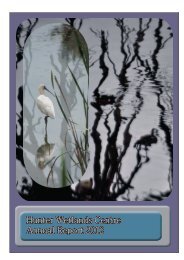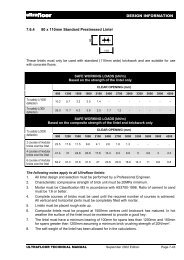FBS-1 Glasswool Insulation Products - Insulation Industries
FBS-1 Glasswool Insulation Products - Insulation Industries
FBS-1 Glasswool Insulation Products - Insulation Industries
You also want an ePaper? Increase the reach of your titles
YUMPU automatically turns print PDFs into web optimized ePapers that Google loves.
MSDS for <strong>FBS</strong>-1 <strong>Glasswool</strong> <strong>Insulation</strong> Page 5 of 6<br />
Incompatible Materials:<br />
Hazardous<br />
Reactions/Decomposition <strong>Products</strong>:<br />
No reported incompatibilities. Acids, alkalis or organic solvents may cause<br />
degradation of resin binder.<br />
None known<br />
SECTION 11: TOXICOLOGICAL INFORMATION<br />
Toxicology data: The fibre component of these products is classified by Safe Work Australia (formerly ASCC/NOHSC) as<br />
Mineral Wool (Not Elsewhere Specified).<br />
In accord with EU ATP 31 (2009) these fibres are not classified as irritant, and being bio-soluble they are not regarded as<br />
carcinogenic. <strong>FBS</strong>-1 <strong>Glasswool</strong> <strong>Insulation</strong> fibres manufactured in Australia and New Zealand (since 2001) are bio-soluble,<br />
which means that any fibres inhaled into the lungs dissolve in body fluids and are then cleared from the lungs. They are<br />
certified as having low biopersistence, e.g. after inhalation, as specified under Note Q as listed in the Australian Hazardous<br />
Substances Information System and in the Australian Approved Criteria documentation. Fibres of these products comply<br />
with the short-term bio-persistence test and fulfil the requirements of Australian and international authorities on biosolubility.<br />
SWA (formerly ASCC/NOHSC) and international authorities do not classify mineral wool fibres with high biosolubility<br />
as carcinogenic or as capable of causing fibrosis.<br />
Fibres are generally clumped by the binder or resin coating and single strand respirable fibre is present only in trace<br />
amounts when any dust is formed in the workplace during installation. Bound fibre is not of respirable size. Extensive<br />
research over the past 50 years on workers handling these fibres and products in many countries has shown that the<br />
inspirable and respirable size fibres are not harmful, having no long term health effects or respiratory effects.<br />
Toxicology test data is generally not available on the products, but is estimated as being very low with LD50 >5000 mg/kg.<br />
Health Effects: Acute (short-term)<br />
Swallowed: Unlikely in normal use, but may result in temporary itching of the lips, mouth and throat. Attempting<br />
to swallow large amounts would be expected to cause gagging and possibly vomiting.<br />
Eyes:<br />
Skin:<br />
Inhaled:<br />
May cause eye discomfort resulting in watering and redness.<br />
Handling repeatedly during installation may cause temporary itching of exposed skin. This is not an<br />
allergy and usually disappears quickly.<br />
Unprotected exposure to high levels of dust of these products (during installation or removal) may<br />
cause discomfort of the nose, throat, and upper and lower respiratory tract, especially in persons<br />
suffering from upper respiratory or chest complaints such as hay fever, asthma or bronchitis.<br />
Note: <strong>Products</strong> used in high temperature applications (above 177°C) may release fumes from the resin bonding during<br />
initial heat-up. In these applications and where suitable protective equipment is not worn (see Section 8), then some<br />
irritation to the eyes, nose, throat and respiratory tract may occur. In confined or poorly ventilated areas, use air-supplied<br />
respirators during the first heat-up cycle.<br />
Health Effects: Chronic (long-term)<br />
There are no known long-term health effects.<br />
SECTION 12: ECOLOGICAL INFORMATION<br />
Eco-toxicity:<br />
Persistence and<br />
Degradability:<br />
Neither the raw materials nor the finished product contain any ozone-depleting chemicals. This<br />
product is not classified as a hazardous air pollutant. No specific data is available on<br />
ecotoxicity, but estimations based on toxicity information suggest that the materials in these<br />
products are not toxic to fish, birds insects or organisms in the environment. No harm to fish or<br />
wildlife would be caused by this product.<br />
<strong>FBS</strong>-1 <strong>Glasswool</strong> <strong>Insulation</strong> is bio-soluble and in most ecosystems it would be expected to<br />
solubilise over a period of weeks to months. Binder-coated insulation wool is hydrophobic, and<br />
no adverse environmental effects would be expected if accidentally released in water or soil.<br />
CSR SDS Reference:<br />
<strong>FBS</strong>-1 <strong>Glasswool</strong><br />
Date Issued: 17 th June 2009



